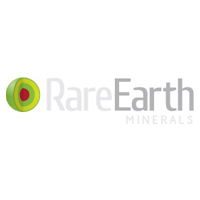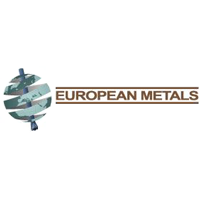European Metals CEO Mr Keith Coughlan said “We are very pleased that the 2015 drilling program which has been completed on time and budget with no accidents and loss time. We received the assays result from the second drillhole PSn05 completed in 2015 and they surpass our expectations and confirm that the lithium mineralization at Cinovec is robust and continuous. The infill hole PSn05 returned an intercept of 152.2m @ 0.47% Li(2) O from 229.9m to end of hole at 382.1m and bottomed in mineralization. Moreover, the mineralized intercept includes a high grade interval of 14m averaging 1.1% Li(2) O, and zones enriched in tin and tungsten that will lower the unit production cost of lithium carbonate as valuable by-products.
Sampling of drill core for the two remaining completed drillholes PSn07 and PSn01 has been completed and the samples are being analyzed in ASL Laboratories. I look forward to providing updates on the drill program and other activities in due course.”
European Metals Holdings Limited (ASX and AIM: EMH) has told DirectorsTalk that four core holes totalling 1655.3m were completed at the Cinovec Lithium-Tin-Tungsten Project in the Czech Republic by the end of 2015. In addition, the results for second completed hole PSn05 have been received.
Key Points:
* Drillhole PSn05 returned intercepts of 29.5m @ 0.25%
Li(2) O from 83.5m to 113m and 152.2m @ 0.47% Li(2) O
from 229.9m to end of hole at 382.1m
* The mineralized intercept includes a high grade
interval of 14m averaging 1.08% Li(2) O, from 276m to
290m depth
* In addition, the lithium intercept contains zones
enriched in Sn and W, i.e. 4m@0.39%Sn (248m to 252m),
3m@0.26%Sn (277m to 280m), and 5m@0.09%W (278m to
283m)
* PSn05 is an infill hole and the analytical results
are in line with the Company's expected grade and
width of the mineralized intercepts
* Four holes (PSn05, PSn06, PSn07 and PSn01) completed
to date for 1655.3m
* All core samples from PSn07 and PSn01 submitted to
ASL Laboratories for analyses
Metallurgical Update
The Company has previously reported that a mini plant trial would be conducted in Q4 2015 in conjunction with Lithium Australia.
This work has not as yet commenced as the Company is first undertaking bench scale test work to fully explore all available recovery techniques.
The current test work will allow an independent trade off study to be finalised as part of the Company’s due diligence on the Lepidico Ltd process as licensed to Lithium Australia to ensure the best result is delivered for the company’s shareholders.
In addition, as part of the pre-feasibility study, the Company has also begun work on trade off studies with regards to plant location and into the potential of the development of high grade outcropping and shallow mineralisation for initial start-up tonnage to accelerate production timelines, lower capital costs and improve project economics.
Drill Program
The current drill program has been planned to facilitate conversion of resources from the Inferred to Indicated category and provide material for metallurgical testing. All four planned diamond core holes PSn06, (designed to twin historic hole CN-51), PSn05 (located 75m south southeast of PSn06), PSn07 and PSn01 have been completed. Visual inspection and logging indicates that geology in these holes is as expected. Drill details are listed in Table 1 below.
After geological logging, drill core is cut in half with a diamond saw. Half core samples are selected (honouring geological boundaries) and dispatched to ALS (Romania) for preparation and assay; the other half of the core is returned to the core box and stored securely on site. Samples are being prepared and analysed by ALS using ICP and XRF techniques following industry standard practice for lithium and tin deposits.
Table 1 – Drillhole details
Hole North East Elevation Depth Azimuth Dip Comments
ID (m) (m)
PSn06 966395.538(1) 778872.879 858.284 401.5 340.5 -89.57 twin of CN-51
-------------- ----------- ---------- ------ -------- ------- --------------------
PSn05 966460.6(2) 778828 858 382.1 301.3 -89.43 confirmation/infill
-------------- ----------- ---------- ------ -------- ------- --------------------
PSn07 966324.5(2) 778873 859.9 417.6 75.1 -89.63 confirmation/infill
-------------- ----------- ---------- ------ -------- ------- --------------------
PSn01 966849.237(1) 778806.417 794.534 454.1 245 -89.60 confirmation/infill
-------------- ----------- ---------- ------ -------- ------- --------------------
Hole locations are recorded in the local S-JTSK Krovak grid
1 Coordinates surveyed 2 Coordinates determined by GPS
Lithium Intercept in PSn05
Drillhole PSn05 is an infill hole testing continuity of mineralization between previously completed drillholes. The geology logged in core and the analytical results agree well with expected information synthesized in the Company’s block model. Hole PSn05 intersected cover barren rhyolite from surface to 83.7m depth, underlain by a narrow pegmatite marking the rhyolite – granite contract and remained in granite to the bottom of the hole. The granite is variably altered and mineralized. Best lithium and Sn-W grades are reported from dark colored sub-horizontal greisen – a quartz-mica-topaz secondary rock replacing the original granite. Major greisen bodies were intersected at the following depths: 229m to 234.2m, 247.3 to 249.6m and 275.9m to 290.8m. The lowermost greisen body is 14.9m thick (apparent thickness but close to true thickens due to shallow dip) and hosts the highest grade mineralization of 14m averaging 1.08% Li(2) O (276m to 290m depth), 3m@0.26%Sn (277m to 280m), and 5m@0.09%W (278m to 283m). The mineralized intercept was calculated at a 0.2% Li(2) O cutoff, with maximum internal waste (marginally below the cutoff grade) of 4m. In this part of the deposit, mineralisation dips at about 10deg to the south, so true width of the intercept in PSn05 is approximately 150m. The intercept in PSn05 is shown in Figure 1, a schematic long section of the Cinovec deposit.
(Please refer to the announcement on the European Metals website for this graphic www.europeanmet.com.)
As required under the 2012 JORC Code, details of the current drill program are appended (Table 2). Holes denoted as CN are historic, drilled in the 1960s to 1980s.
ABOUT THE PROJECT
Cinovec is a globally significant lithium and tin deposit with the potential to be a very low cost producer of lithium carbonate.
Key Points
* Largest lithium deposit in Europe
* Positive Scoping Study completed
* Potential to be the lowest cost lithium carbonate
producer
* Centrally located to major European end-users
PROJECT OVERVIEW
Cinovec Lithium/Tin Project
European Metals owns 100% of the Exploration Rights to the Cinovec lithium-tin deposit in the Czech Republic. Cinovec is an historic mine incorporating a significant undeveloped lithium-tin resource with by-product potential including tungsten, rubidium, scandium, niobium and tantalum. Cinovec hosts a globally significant hard rock lithium deposit with a total Inferred Mineral Resource of 514.8Mt @ 0.43% Li(2) O. Within this resource lies one of the largest undeveloped tin deposits in the world, with total Indicated and Inferred Mineral Resources of 79.7Mt grading 0.23% Sn for 183kt of contained tin. The Mineral Resource estimates are based primarily on over 83,000m of historic drilling and 21.5km of historic underground exploration drifting completed by the Czechoslovakian Government from the 1960s through to the 1980s. The deposit has previously had over 400,000 tonnes trial mined as a sub-level open stope underground mining operation.
A Scoping Study conducted by specialist independent consultants indicates the deposit could be amenable to bulk underground mining. Metallurgical testwork has produced both battery grade lithium carbonate and high grade tin concentrate at excellent recoveries with the Scoping Study revealing a potential production cost of approximately $800 per tonne of lithium carbonate including tin and tungsten credits. Cinovec is centrally located for European end-users and is well serviced by infrastructure, with a sealed road adjacent to the deposit, rail lines located 5km north and 8km south of the deposit and an active 22kV transmission line running to the historic mine. As the deposit lies in an active mining region, it has strong community support.



